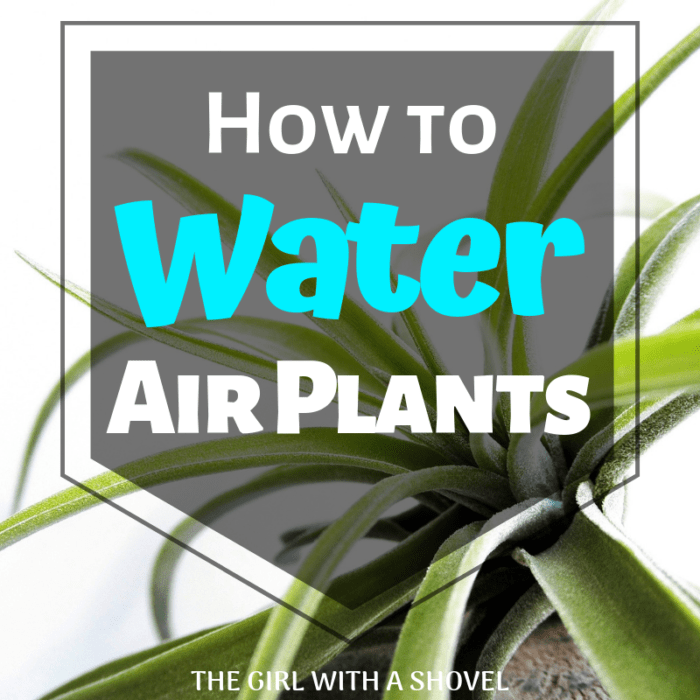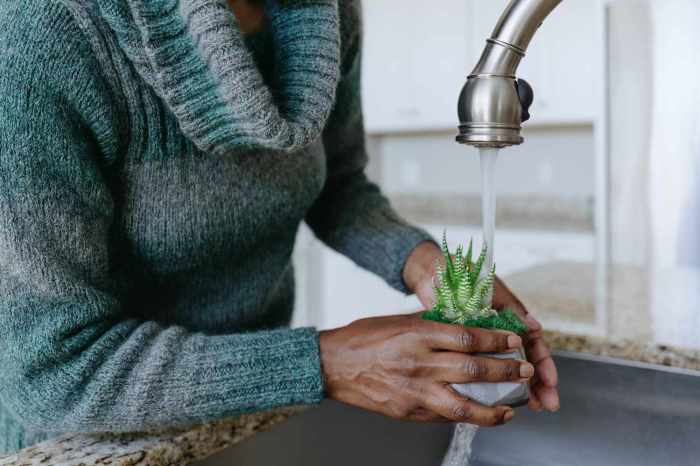Can You Water Air Plants With Tap Water?
Watering Air Plants with Tap Water: A Comprehensive Guide: Can You Water Air Plants With Tap Water
Can you water air plants with tap water – Air plants, or Tillandsia, are known for their low-maintenance nature, but even these resilient plants require careful consideration when it comes to watering. While many sources recommend rainwater or distilled water, tap water is often a readily available alternative. However, understanding the composition of tap water and its potential effects on air plants is crucial for ensuring their health and longevity.
This guide will explore the nuances of using tap water for air plants, outlining both the potential risks and methods for minimizing them.
Tap Water Composition and Air Plant Sensitivity

Source: thegirlwithashovel.com
Tap water’s mineral content varies significantly depending on geographical location and water treatment processes. Some regions have hard water, rich in minerals like calcium and magnesium, while others have soft water with lower mineral concentrations. Chlorine, fluoride, and other chemicals added during treatment can also impact air plant health. High mineral content can lead to salt buildup on the leaves, hindering their ability to absorb nutrients and potentially causing leaf discoloration and browning.
Chlorine and fluoride, while generally safe for humans, can be harsh on the delicate trichomes (tiny hair-like structures) of air plants, disrupting their ability to absorb moisture and nutrients. Hard water’s high mineral content can accumulate faster than soft water, increasing the risk of salt buildup.
The accumulation of minerals occurs through repeated watering. As the water evaporates, the dissolved minerals are left behind on the plant’s leaves and in the plant’s base. Over time, this buildup forms a crust, obstructing the trichomes and preventing proper hydration and respiration.
| Water Type | Mineral Content | Chlorine/Fluoride | Suitability for Air Plants |
|---|---|---|---|
| Tap Water | Varies greatly; can be high or low | Present; levels vary | Conditional; requires careful monitoring and potential treatment |
| Filtered Water | Reduced mineral content | Reduced or absent | Generally good; reduces risks associated with tap water |
| Distilled Water | Minimal to no minerals | Absent | Excellent; ideal but can lack essential nutrients |
| Rainwater | Low mineral content; naturally soft | Absent | Excellent; naturally purified |
Watering Methods and Techniques for Air Plants Using Tap Water

Source: southernliving.com
Several methods exist for watering air plants with tap water, each with its own advantages and disadvantages. Proper watering frequency depends on factors such as environment (humidity, temperature, sunlight), plant size, and pot type (if potted). Always ensure proper drainage to prevent root rot.
- Soaking: Submerge the air plant in a bowl of tap water for 20-30 minutes, ensuring the plant is completely saturated. Allow it to fully drain afterwards, upside down, for at least an hour to prevent waterlogging.
- Misting: Spray the air plant with tap water several times a week, ensuring the plant is evenly moistened. This method is best suited for humid environments.
- Showering: Gently shower the air plant with lukewarm tap water for a few minutes. Allow it to air dry completely afterward.
A step-by-step guide for soaking:
- Fill a bowl with room temperature tap water. Visual: A clear glass bowl filled halfway with clear water.
- Gently submerge the air plant, ensuring all parts are wet. Visual: An air plant fully submerged in the bowl of water, its leaves completely covered.
- Let it soak for 20-30 minutes. Visual: The bowl of water with the air plant soaking, a timer visible showing the remaining soaking time.
- Remove the air plant and gently shake off excess water. Visual: A hand carefully removing the air plant from the water, some water dripping off.
- Turn the plant upside down and let it drain completely for at least an hour. Visual: The air plant hanging upside down, allowing excess water to drip off.
Signs of Tap Water Damage in Air Plants
Several visual cues indicate potential tap water damage. These symptoms can differ depending on whether the issue stems from overwatering or underwatering. It’s crucial to distinguish these symptoms from other potential problems like pest infestations or disease.
- Leaf discoloration: Brown or yellowing leaves, especially at the tips or edges, can signal mineral buildup or chlorine damage. Visual: An air plant with brown tips on several leaves, contrasting with the green healthy parts.
- Wilting: Drooping or shriveled leaves, coupled with dry soil (if potted), may indicate underwatering. However, if the leaves are soft and mushy, it could be a sign of root rot from overwatering. Visual: An air plant with visibly droopy and shriveled leaves. Another image showing soft, mushy leaves.
- Root rot (for potted plants): Dark, slimy roots are a clear sign of overwatering, often caused by poor drainage. Visual: A close-up of dark, mushy roots, contrasting with healthy, firm roots in another image.
- Salt buildup: A white, crusty residue on the leaves indicates mineral accumulation from tap water. Visual: An air plant with visible white, crystalline deposits on its leaves.
Alternatives to Tap Water for Air Plants
Several alternatives to tap water offer safer hydration for air plants. Each has its own advantages and disadvantages.
- Filtered Water: Reduces chlorine and some minerals. Advantages: readily available, convenient. Disadvantages: may still contain some minerals.
- Distilled Water: Removes almost all minerals and impurities. Advantages: safest option, minimizes mineral buildup. Disadvantages: lacks essential nutrients.
- Rainwater: Naturally soft and low in minerals. Advantages: naturally purified, ideal for air plants. Disadvantages: requires collection and storage, potential for contamination.
Letting tap water sit overnight allows chlorine to dissipate somewhat, reducing its harshness on the plant.
Long-Term Effects of Using Tap Water on Air Plants, Can you water air plants with tap water
Consistent use of untreated tap water can lead to long-term health problems for air plants, potentially shortening their lifespan and impacting their reproductive capabilities. Mineral buildup can progressively damage the trichomes, hindering their ability to absorb nutrients and moisture. This can result in stunted growth, weakened plants, and a reduced flowering rate. While occasional use might not cause significant harm, frequent use of hard tap water is strongly discouraged.
Using treated tap water or alternative sources is recommended for optimal air plant health and longevity. Using tap water is acceptable for occasional watering, particularly if it’s soft and you monitor the plant closely for signs of damage. However, consistent use without monitoring is strongly discouraged.
FAQ Summary
Can I use softened tap water for my air plants?
Softened water, while removing minerals, can sometimes contain high levels of sodium, which isn’t ideal for air plants. It’s best to use filtered or rainwater instead.
How often should I soak my air plants if using tap water?
Soaking frequency depends on environmental factors. In drier climates, soak weekly; in humid ones, every 1-2 weeks. Always ensure complete drainage afterward.
My air plant leaves are turning brown; is it tap water?
While tap water’s mineral content can sometimes harm air plants, it’s a common question whether it’s suitable. The same concerns about water quality apply to other plants; for instance, you might wonder, as detailed in this article can you put spider plants in water , before deciding on a watering method. Ultimately, understanding the specific needs of your air plants, just like spider plants, is key to their health.
Brown leaves can indicate tap water damage (mineral buildup), overwatering, or underwatering. Examine the roots for rot; if present, it’s likely overwatering. If the leaves are dry and brittle, it’s likely underwatering.
Can I use tap water for newly purchased air plants?
It’s advisable to use filtered or rainwater for newly purchased air plants to minimize stress during acclimation. Transition to tap water gradually, observing for any negative reactions.




















